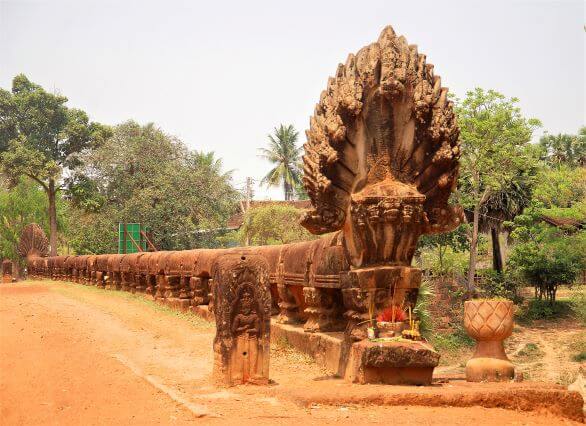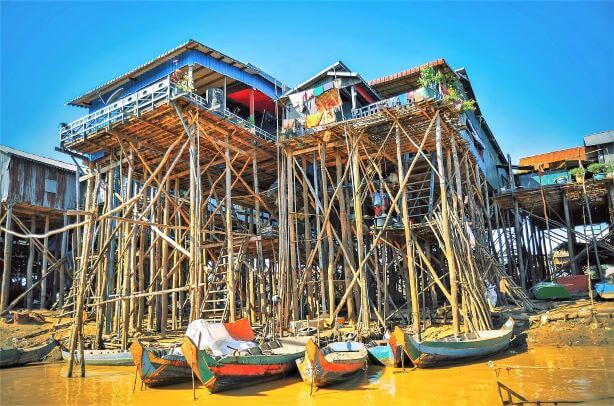HIGHLIGHTS OF CAMBODIA TOUR
10 DAYS
OVERVIEW
Cambodia
ITINERARY
10 days all highlights of Cambodia
Day 1: Upon arrival in Phnom Penh International: and transfer to your hotel. Afternoon, Phnom Penh city tour: Visit the Victory Monument, and the National Museum, also called Musee des Beaux-Arts. A French archaeologist and painter, Georges Groslier, designed it in Khmer style in 1917. The museum contains a collection of Khmer art – notably sculptures – from throughout the ages. Visit the Royal Palace, built by King Norodom in 1866 on the site of the old town, and the Silver Pagoda. Located within the grounds of the Royal Palace, the Silver Pagoda is so named because of its floor, which is made up of 5000 silver tiles. The treasures found inside include a solid gold Buddha encrusted and weighing 90 kilograms and a small 17th century emerald and baccarat crystal Buddha. End your afternoon with the visit of the Wat Phnom Temple, Phnom Penh’s namesake, from where you can enjoy views over the tree-lined avenues of the city during sunset. Overnight in Phnom Penh
Day 2: Phnom Penh – Kratie: Breakfast at hotel, drive to Kratie via Kompong Cham & Snuol. Arrive in Kratie and check in at hotel. In the afternoon, city tour of this small provincial town with its good examples of sumptuous colonial architecture. This tiny town on the Mekong is an unexpected delight, with a relaxing, indolent atmosphere. Further north stop at the best riverside vantage point from which to view the rare freshwaterIrrawady dolphins which can be best seen late afternoon. Then, drive back to Kratie. Overnight in Kratie at Rajabori Villas Resort,
Day 3: Kratie – Kompong Cham – Kompong Thom: Morning, visit Kratie Pagoda and market. Continue to Chhup, the biggest rubber plantation in the country, established during the French colonial time by the French tire maker Michelin. Visit Wat Nokor Pagoda with its ancient temple and modern style pagoda (12th century) and then drive to Kompong Thom. Arrive in Kompong Thom and check-in at hotel. Overnight at the Sambor Village
Day 4: Kompong Thom – Siem Reap: After breakfast, depart Kompong Thom for Sambor Prei Kuk, located 35 km northeast of Kompong Thom. Visit the ancient capital of Chenla with its 100 temples dating from the Pre-Angkorian period. Continue to Siem Reap (the road from Kompong Thom to Siem Reap is now in good condition. The drive takes around 2.5 hours). En route, visit traditional villages and stop at the ancient Naga Bridge (Spean Pratpo), located 40 km from Siem Reap. Arrive in Siem Reap and transfer to hotel. This afternoon, begin a tour of the temple visit Prasat Kravan with its unique brick sculptures and Ta Prohm. One of the area ‘ s most beautiful temples, Ta Prohm has been relatively untouched since it was discovered and retains much of its mystery. Its appeal lies in the fact that, unlike the other monuments of Angkor, it was abandoned and swallowed by the jungle, looking very much the ways most of the Angkor temples appeared when European explorers first stumbled upon them. Visit as well Takeo, Chau Say Tevoda and Thommanon. Then transfer back to hotel. Overnight in Siem Reap
Day 5: Siem Reap: Early bird special
Transfer to the archaeological site for sunrise from Phnom Bakheng, one of two hills dominating the plain of Angkor, from where you will have a spectacular view of the Western Baray and Angkor Wat.
Or sunrise at Srah Srang
Then visit the South Gate (with its huge statues depicting the churning of the ocean of milk), the ancient capital of Angkor Thom (12th century), Bayon Temple (unique for its 54 towers decorated with over 200 smiling faces of Avolokitesvara), the Royal Enclosure, Phimeanakas (Vimean Akhar), the Elephants Terrace and the Terrace of the Leper King. Afternoon, visit the most famous of all the temples on the plain of Angkor: Angkor Wat. The temple complex covers 81 hectares and is comparable in size to the Imperial Palace in Beijing . Its distinctive five towers are emblazoned on the Cambodian flag and the 12th century masterpiece is considered by art historians to be the prime example of classical Khmer art and architecture. Angkor Wat ‘ s five towers symbolize Meru ‘ s five peaks – the enclosed wall represents the mountains at the edge of the world and the surrounding moat, the ocean beyond. Sunset at Angkor Wat. Overnight at the same hotel.
Day 6: (B): Siem Reap: Morning, drive to the remote Beng Mealea Temple through the typical Khmer countryside (60 km from Siem Reap). Explore the long abandoned temple (11th century), strangled by the jungle. Proceed to the Banteay Srei Temple (10th century) regarded as the jewel in the crown of classical Khmer art. Then visit Banteay Samre, one of the most complete complexes at Angkor due to restoration using the method of “anastylosis”. The name Samre refers to an ethnic group of mountain people, who inhabited the region at the base of Phnom Kulen and were probably related to the Khmers. No inscriptions have been found for this temple, but the style of most of the architecture is of the classic art of the middle period similar to Angkor Wat. The proportions of Banteay Samre are splendid. A unique feature is an interior moat with laterite paving, which when filled with water must have given an ethereal atmosphere to the temple. Then continue to visit the Kbal Spean. Overnight at the same hotel.
Day 7: (B): Siem Reap: Morning, visit the Roluos Group. The monuments of Roluos, which served as the capital of Indravarman I (reigned 877-89), are among the earliest large, permanent temples built by the Khmers and mark the beginning of Khmer classical art. Preah Ko erected by Indravarman I in the late 9th century dedicated by the King to his ancestors in 880. Bakong the largest and most interesting of the Roluos group temples, with his active Buddhist monastery just to the north of the east entrance. Lolei built on an islet in the center of a large reservoir (now rice fields) by Yasovarman I, the founder to the first city at Angkor.
In the afternoon, you continue your temple visits to Preah Khan. Built by the King Jayavarman VII, Preah Khan is, like Ta Prohm, a place of towered enclosures and shoulder hugging corridors. Unlike Ta Prohm, however, the temple of Preah Khan is in a reasonable state of preservation and ongoing restoration efforts should maintain and even improve this situation. Neak Pean, a fountain built in the middle of a pool (representing the paradisiacal Himalayan mountain-lake), Ta Som. Overnight at the same hotel.
Day 8: Siem Reap – Battambang (by boat): Travel by boat from Siem Reap to Battambang. Cross the Tonle Sap Lake and the floating village of Prek Tuol . Stop at Cheur Khmao Pagoda “Black Wood Pagoda”. Enjoy the unspoiled landscapes and traditional daily-life scenes along Sangker River. Arrive at Battambang port and transfer to hotel. Visit the Provincial Museum and the local market. Drive to Phnom Banon, with its five sandstone towers on top of a hill and enjoy a magnificent view of the surrounding plains until sunset. Overnight in Battambang
Day 9: Battambang – Phnom Penh: Stroll through the city with its well preserve example of colonial architecture and visit the local market. Then drive along the picturesque Sangker River to Wat Slaket Pagoda, the residence of the provincial Buddhist patriarch. Continue to visit Wat Ek Phnom (11th century – Suryavarman I). Overland transfer from Battambang to Phnom Penh with a visit of the pottery village in Kompong Chhnang. Overnight at the Plantation hotel in Phnom Penh
Day 10: (B): Phnom Penh – Back home: After breakfast, transfer to airport for your flight back home. End service.





